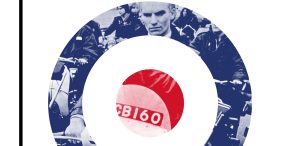When it comes to modernism, there are no hard-and-fast rules. While Britain’s sharpest subculture has a look, sound and attitude all of its own, it has always assimilated new and relevant ideas, representing and reflecting the desires and aspirations of the British youths who flew its flag initially, in the late 1950’s. Beginning with cool jazz, trim Italian tailoring and the convenience of scooter transportation; over time it developed into a dance culture, with beat music and motown, then ska and new wave at its heart. It took hold in ‘60s Britain, with many youths devoting themselves to its lifestyle, before enjoying revivals in ensuing decades and remaining, for some Brits, the ultimate symbol of cool, to the present day.
While many things are integral to the mod subculture, music and fashion are perhaps its two foremost aspects. A mod in ‘60s Britain might find their toes tapping to Booker T & The M.G.’s Green Onions, now the movement’s undisputed anthem, with its clean and warm electric organ lines, bluesy backbone and wicked rhythm courtesy of twangy Telecaster guitar. They might have jived to the four four beat of Bert’s Apple Crumble and if they wanted to communicate their emotions to a new-found flame, harnessed the tender voice of a Motown balladress like Mary Wells.
Music was the catalyst to many a mod love affair and ultimately led to the movement’s defining film as well as inspiring one of the revival’s defining musicians in Paul Weller. We celebrate the mod subculture with a screening of Quadrophenia and a floor-filling mod disco this Saturday, and welcome Style Council tribute outfit The Style Councillors to Band on the Wall later this month.
Quadrophenia drops the viewer into the throws of mod life like no other film. The creation of director Franc Roddam, it takes inspiration from The Who’s 1973 rock opera of the same name, following the life of a working-class mod looking for love, clashing with rockers and searching for a calling in life. Its gritty and dramatic but also captures the hedonism of the mod lifestyle, with the music, style and energy integral to the appeal that helped spurn a mod revival after it’s 1979 release.
The insuing mod revival undoubtably influenced the musical development of Paul Weller, then leader of influencial post-punk band, The Jam. The Jam had already gained a reputation as outliers in the punk field, wearing sharp suits like new wavers Elvis Costello & The Attractions and tuning their instruments before live performances, but still playing as raucously as the punks. As they developed, heading ultimately towards a break-up, the sounds of soul and R&B, pillars of mod culture and influences on Weller’s songwriting, became ever present. Those influences were fully realised in the creation of Weller’s new band, The Style Council, in 1983. The sharply dressed frontman forged a pop sound that had modernist principles and hallmarks of the music that made mods tick. There was hammond organ alongside fresh programmed percussion, twangy R&B guitar alongside synth bass; it was a slique and stylish reimagining of what mod stood for, with soul and jazz as present in the mix and songwriting as the rock and R&B upon which Weller had established his reputation.
The Style Councillors capture all that made Weller and Talbot’s band unique, with a ten-piece live band to realise their most naunced of R&B masterpieces. They take you back to the beginning, to Long Hot Summer and The Paris Match, themselves sporting the same sharp mod threads that earned Weller his modfather status.
Pick up tickets for our Quadrophenia screening and mod disco on Saturday 5th August here and find tickets for The Style Councillors show on 25th August here.



